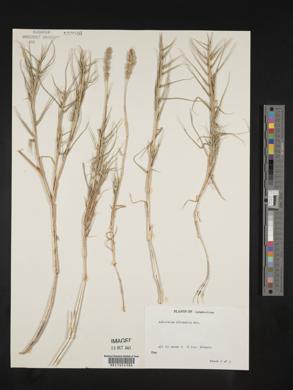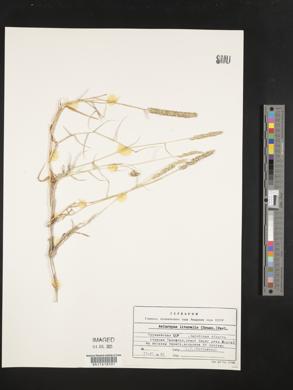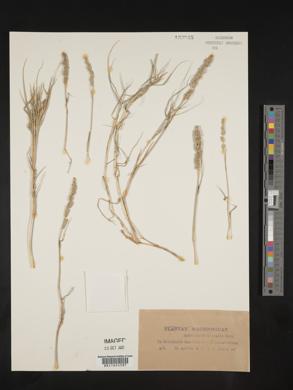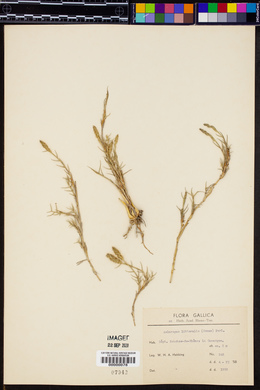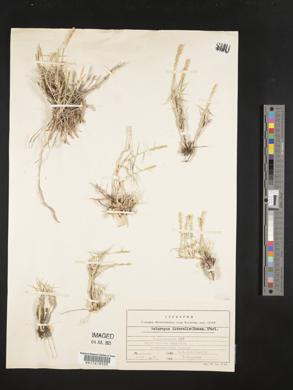Aeluropus littoralis
|
|
|
|
Family: Poaceae
[Dactylis littoralis (Gouan) Willd., morePoa littoralis Gouan] |
Plants both rhizomatous and stoloniferous. Culms 9-25 cm, erect or decumbent. Sheaths strongly ridged, glabrous; blades 1.5-7 cm, adaxial surfaces glabrous, scabridulous, or sparsely hairy, strongly and closely ridged. Panicles 1-7 cm long, 4-10 mm wide, with 4-13 branches, each bearing 12 or more spikelets; lower branches usually not overlapping. Spikelets 3-4.5 mm, ovoid, with 6-9 florets. Glumes unequal, veins scabrous, margins glabrous or hairy; lower glumes1-2.5 mm, 1-4-veined; upper glumes 1.5-3 mm, 3-6-veined; lemmas 1.5-4 mm, 9-11-veined, veins scabrous, margins glabrous or hairy, apices mucronate, mucros 0.1-0.3 mm; paleas hyaline, keels ciliolate; anthers 1-1.5 mm. Caryopses strongly compressed. 2n = 20. Aeluropus littoralis is native to Eurasia, where it grows in sandy, often saline habitats. It has been cultivated experimentally in Pima County, Arizona; it is not established in the Flora region. Dr. David Bogler, USDA NRCS PLANTS Database Perennials, Terrestrial, not aquatic, Rhizomes present, Rhizome elongate, creeping, stems distant, Stolons or runners present, Basal sheaths fibrous, old leaves persistent at base of plant, Stems trailing, spreading or prostrate, Stems nodes swollen or brittle, Stems erect or ascending, Stems geniculate, decumbent, or lax, sometimes rooting at nodes, Stems solitary, Stems terete, round in cross section, or polygonal, Stem internodes hollow, Stems with inflorescence less than 1 m tall, Leaves mostly cauline, Leaves conspicuously 2-ranked, distichous, Leaves sheathing at base, Leaf sheath mostly open, or loose, Leaf sheath smooth, glabrous, Leaf sheath or blade keeled, Leaf sheath and blade differentiated, Leaf blades linear, Leaf blades very narrow or filiform, less than 2 mm wide, Leaf blades mostly flat, Leaf blade margins folded, involute, or conduplicate, Leaf blades mostly glabrous, Leaf blades scabrous, roughened, or wrinkled, Leaf blades glaucous, blue-green, or grey, or with white glands, Ligule present, Ligule a fringed, ciliate, or lobed membrane, Inflorescence terminal, Inflorescence a dense slender spike-like panicle or raceme, branches contracted, Inflorescence solitary, with 1 spike, fascicle, glomerule, head, or cluster per stem or culm, Inflorescence a panicle with narrowly racemose or spicate branches, Inflorescence with 2-10 branches, Inflorescence branches 1-sided, Flowers bisexual, Spikelets sessile or subsessile, Spikelets laterally compressed, Spikelet less than 3 mm wide, Spikelets with 3-7 florets, Spikelets with 8-40 florets, Spikelets solitary at rachis nodes, Spikelets distichously arranged, Spikelets all alike and fertille, Spikelets bisexual, Spikelets disarticulating beneath or between the florets, Spikelets not disarticulating, or tardy, Rachilla or pedicel glabrous, Glumes present, empty bracts, Glumes 2 clearly present, Glumes equal or subequal, Glumes distinctly unequal, Glumes shorter than adjacent lemma, Glumes keeled or winged, Glumes 1 nerved, Glumes 3 nerved, Lemmas thin, chartaceous, hyaline, cartilag inous, or membranous, Lemma similar in texture to glumes, Lemma 8-15 nerved, Lemma glabrous, Lemma apex acute or acuminate, Lemma awnless, Lemma mucronate, very shortly beaked or awned, less than 1-2 mm, Lemma margins thin, lying flat, Lemma straight, Palea present, well developed, Palea membranous, hyaline, Palea about equal to lemma, Palea 2 nerved or 2 keeled, Palea keels winged, scabrous, or ciliate, Stamens 3, Style |
|
|
|



















